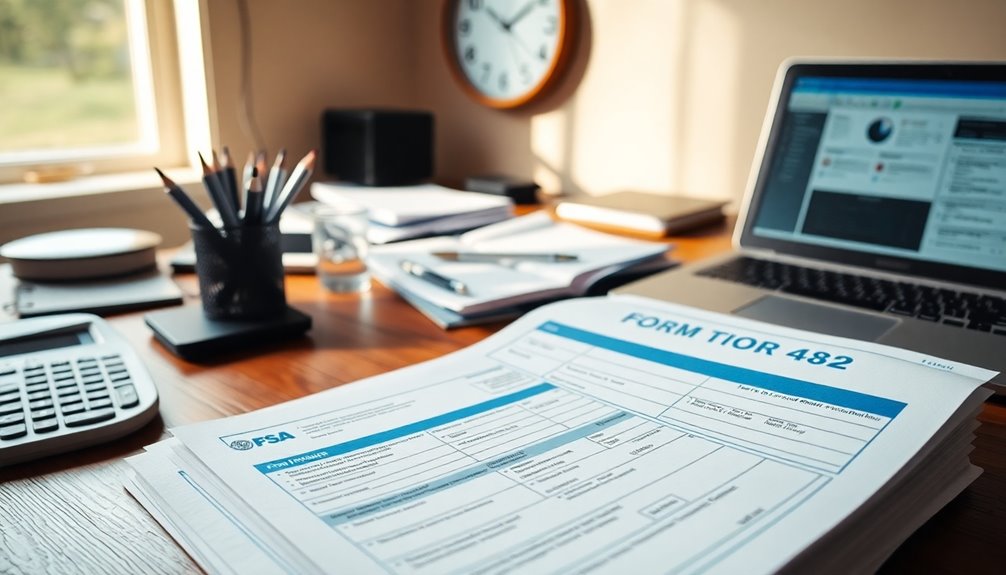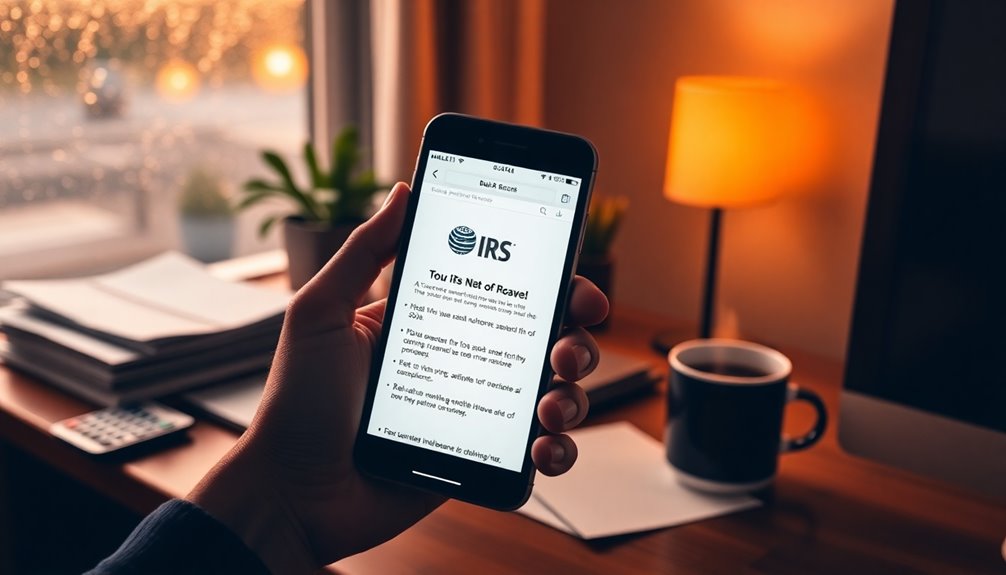If you haven't received your W-2, you can still file your taxes. Start by estimating your wages and tax withholdings using your final pay stub. Next, complete Form 4852, which acts as a substitute for your W-2, and attach it to your tax return. Make sure to provide accurate estimates based on your income and withholding records. If your employer doesn't respond when you request your W-2, contact the IRS for guidance. You'll want to keep copies of all forms submitted. Stick around, and you'll discover more tips on ensuring a smooth filing process.
Key Takeaways
- Estimate your wages and tax withholding using your final pay stub if your W-2 is unavailable.
- Request your missing W-2 from your employer and contact the IRS if you receive no response.
- Use Form 4852 as a substitute for the W-2 and attach it to your tax return; it cannot be e-filed.
- For self-employed individuals, utilize Form 1099-NEC, Schedule C, and Schedule SE to report income.
- Consider filing for an extension using Form 4868 if you need more time to gather documents.
Understanding W-2 Requirements

When you're filing your taxes, understanding W-2 requirements is essential. You'll need to know that employers must issue W-2 forms to all employees by January 31 for the previous tax year. This deadline is crucial, as employers also have to submit these forms to the IRS by the same date. If either you or your employer misses this deadline, it could result in penalties.
The W-2 form provides a detailed account of your total annual wages and the taxes withheld from your paycheck, including federal income tax, Social Security, and Medicare taxes. It's vital that the information on the form, like your name and Social Security number, matches what's on your Social Security card. If there are discrepancies, it could affect your tax filing and future benefits.
Moreover, the W-2 includes data on state and local tax withholdings, as well as any employer benefits like retirement plans or insurance. This form is key not just for federal taxes but also for accurate state tax returns. Additionally, employers must file W-2 forms with the SSA electronically by January 31 to ensure compliance.
Ensuring all details are correct helps avoid errors and keeps you compliant with tax regulations.
Steps to Obtain a W-2

Obtaining your W-2 form can be straightforward if you follow the right steps. First, check the date; employers must mail W-2 forms by January 31, but they mightn't arrive until early February. If you haven't received it by February 14, it's time to take action.
Start by verifying your mailing address with your employer. Ensure that they've your correct address on file, especially if you've moved recently.
If you still don't have your W-2, reach out to your HR department or payroll office. For smaller companies, contacting your immediate supervisor can also help. Ask if the form was sent and if it can be resent via email or a secure portal.
If your employer provides digital access, check your email, including your spam folder, or log into their secure online platform. Additionally, all employees receiving wages, including part-time and full-time workers, have a right to a W-2 form.
If you're trying to obtain a W-2 from a previous employer, reach out to their HR department or former manager.
If all else fails, consider contacting the IRS for assistance after February 14. By staying proactive, you can ensure you receive your W-2 efficiently.
Using Form 4852 Effectively

Filing your taxes without a W-2 can feel daunting, but using Form 4852 effectively simplifies the process. Start by ensuring you attach Form 4852 to the back of your income tax return, before any supporting forms or schedules.
Accuracy is key, so fill it out as precisely as possible. If you don't have exact figures, use informed estimates, but be aware that the IRS might ask for additional documentation later. Form 4852 is essential for accurate reporting and helps maintain compliance with IRS income reporting requirements.
Be mindful of potential penalties for improper use of Form 4852, such as accuracy-related penalties or even a $5,000 civil penalty for frivolous returns. Retain a copy of the form for your records, especially for future verification with the Social Security Administration.
When completing the form, provide your full legal name, address, and Social Security number. Identify the missing W-2 or 1099-R and include your employer's details if known.
Don't forget to briefly narrate your efforts to obtain the missing forms. Lastly, make sure you're using the correct version of Form 4852 for the tax year you're filing. This preparation can help keep your tax process smooth and compliant.
Information Needed for Form 4852

Completing Form 4852 requires specific information to ensure the IRS processes your tax return correctly. Start by gathering your personal information, including your full legal name, current residential address, Social Security number, and phone number. You'll also need a physical address for IRS communication.
Next, collect details about your employer or payer. This includes their full name, address, and Employer Identification Number (EIN) if you have it. If applicable, provide the name of the owner or contact person and their phone number.
For the tax year in question, specify which form is missing—either Form W-2 or Form 1099-R—and explain why you didn't receive it. Include the dates of your employment and the reason for using Form 4852. Remember that Form 4852 is used as a backup for missing or incorrect tax documents, which helps ensure compliance with IRS regulations.
Finally, you'll need to report your income and withholding information. This includes your total gross wages, federal income tax withheld, and any state or local income tax withheld.
Don't forget to include your Social Security and Medicare wages, as well as the method you used to determine these totals, like referencing your last pay stub.
Filing Taxes Without a W-2

When you don't receive a W-2, it can feel overwhelming, but you can still file your taxes successfully. Start by estimating your wages and tax withholding using your final pay stub. Next, reach out to your employer to request the missing W-2. If they don't respond, contact the IRS for help.
If you still can't obtain your W-2, fill out Form 4852. This form acts as a substitute for your W-2, allowing you to report your estimated wages and withholding. Remember, you must attach Form 4852 to your tax return, which you'll have to mail since it can't be e-filed. Employers must provide W-2 by January 31, so it's important to act quickly.
For self-employed individuals, you'll need to use Form 1099-NEC, Schedule C, and Schedule SE to report your income and self-employment tax. If you work for a foreign employer, report your income directly on Form 1040.
Be aware that filing with Form 4852 could delay processing and increase the risk of errors or audits. Always ensure you're accounting for any local and state taxes as well.
If needed, consider filing for an extension using Form 4868 while waiting for your W-2 or resolving issues.
Addressing Discrepancies Post-Filing

Addressing discrepancies after filing your tax return can feel daunting, but it's crucial for ensuring your records are accurate. Start by identifying the specific error on your original tax return. Gather necessary documentation to support your correction, including any omitted forms or schedules.
Once you know what needs fixing, determine the correct amended form: Form 1040-X for individuals, Form 1120-X for corporations, or Form 1065-X for partnerships.
Next, complete the appropriate amended return form following the provided instructions. Include any relevant forms or schedules that were changed or omitted and clearly explain the reason for your amendment. Additionally, ensure your filing is accurate to avoid penalties and interest that may arise from errors.
Don't forget to double-check all calculations to avoid further errors. When you're ready, submit the amended form to the appropriate IRS address. If you're responding to an IRS notice, use the address indicated on that notice.
After submission, track the status of your amended return using the IRS tools available. Remember, interest and penalties may accumulate if you don't address the error promptly. Keep records of your submission and any communications with the IRS to ensure you stay organized throughout this process.
Requesting Wage and Income Transcript

Navigating the complexities of tax filing can be overwhelming, especially without a W-2. One effective solution is to request a Wage and Income Transcript from the IRS. You can do this online, by phone, or by mail.
To request it online, visit the IRS website at www.irs.gov/individuals/get-transcript. Click "Get Transcript ONLINE" and log in using ID.me. Enter your Social Security Number (SSN) or Individual Tax Identification Number (ITIN), date of birth, and address from your latest tax return. This process is essential for managing your financial activities effectively.
Select "Higher Education/Student Aid" as the reason for the transcript if applicable and choose the specific tax year you need. After validation, you can view and print the transcript immediately.
If you prefer to request it by phone, call the IRS at 800-908-9946 and follow the prompts. Specify the tax year you need, and the transcript will be mailed to your address on file within 5 to 10 business days.
For mail requests, complete Form 4506-T and send it to the IRS. Provide your identification details and specify the tax year. Expect a similar wait time for the transcript to arrive.
General Filing Instructions

Filing your taxes without a W-2 can seem daunting, but understanding the necessary steps simplifies the process.
First, if you haven't received your W-2 by January 31, reach out to your employer directly to request a copy. If they don't respond, contact the IRS helpline at +1-(800)-829-1040 for assistance.
In cases where you worked for a foreign employer, you won't receive a W-2, so you'll need to report your income on Form 1040, line 1h.
If you can't get your W-2, use Form 4852 as a substitute. Estimate your total wages and withholding based on your final pay stub, and fill out Form 4852 with this information. Accurate income reporting is essential to avoid potential penalties from the IRS.
Attach it to your Form 1040 when you submit your return by mail, since Form 4852 can't be e-filed.
Prepare your tax return using the estimated wages from Form 4852 and include any other necessary income documents, like Forms 1099-NEC or 1099-DIV.
After completing your return, mail it along with Form 4852, ensuring all required schedules are included and using black ink for clarity.
Tips to Avoid Delays

When you're preparing to file taxes without a W-2, taking proactive steps can help you avoid delays. First, gather all necessary tax documents, including any W-2s or Form 1099s. Keep these documents in one designated spot to prevent misplacement. Organize them by type—income, deductions, and credits—to streamline your filing process.
If you lack a W-2, complete IRS Form 4852 using information from your last pay stub. Attach this form to your paper tax return, as it can't be e-filed, and be aware that using Form 4852 may lead to longer processing times. Opt for electronic filing to expedite your return and refund. Use direct deposit for your refund to speed up the receipt of funds. Avoid paper returns, which typically take longer to process. E-filing accelerates the processing of tax returns compared to paper filing.
Lastly, double-check your tax return for errors before submission. Ensure it's signed and dated, or complete Form 8879 for e-filing. Avoid requesting a paper refund to prevent additional delays.
Frequently Asked Questions
Can I File Taxes Without Any Income Documentation?
Yes, you can file taxes without any income documentation.
It's legal to submit a return showing zero income, and doing so might help you claim credits like the Earned Income Tax Credit.
Just add a small amount, like $1 of interest income, to avoid rejection.
Make sure to follow the necessary steps in your tax software to include this, and keep all records for future reference.
Filing also helps keep your IRS records updated.
What Happens if I Estimate My Wages Incorrectly?
If you estimate your wages incorrectly, you could face penalties for underpayment.
The IRS requires that your total withholding and estimated payments meet certain thresholds, usually 90% of the current year's tax. If you fall short, you'll likely owe interest and penalties.
To avoid this, make sure your quarterly payments reflect at least 25% of your estimated tax, and consider adjusting your estimates if you discover errors.
How Long Will It Take to Process My Tax Return?
When you file your tax return, processing time can vary significantly based on your method.
If you e-file, expect your refund in less than 21 days after the IRS receives your return.
Paper filing, however, typically takes 6-8 weeks, with potential delays due to backlogs.
Ensure your information is accurate to avoid issues.
You can track your refund status using the IRS "Where's My Refund" tool or the IRS2Go mobile app for updates.
Will Filing Without a W-2 Affect My Refund?
Filing without a W-2 can definitely affect your refund. Since you'll likely use Form 4852, the IRS will manually process your return, leading to potential delays.
If your estimated information differs from the actual W-2 received later, you'll need to file an amended return, further slowing things down. So, be prepared for a longer wait before seeing that refund.
It's crucial to file accurately to avoid penalties and issues with the IRS.
Can I Use a 1099 Form Instead of a W-2?
You can't use a 1099 form instead of a W-2 for employee income.
A W-2 reports wages for employees, while a 1099 is meant for independent contractors.
If you're classified as an employee, you need a W-2 to ensure accurate reporting and compliance with IRS regulations.
Using a 1099 for employee income can lead to penalties and loss of benefits, so it's essential to have the correct form.
Conclusion
In conclusion, filing taxes without a W-2 can be challenging, but it's definitely manageable. By using Form 4852 and gathering all necessary information, you can accurately report your income. Don't forget to keep track of any discrepancies after filing and request a wage and income transcript if needed. Follow these steps, stay organized, and you'll navigate the process smoothly. Remember, taking the right actions now can save you headaches later on!









